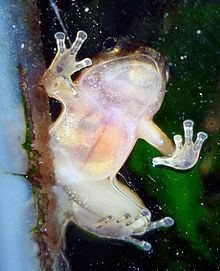Phylum Chordata Rank Species | Scientific name Mannophryne trinitatis Higher classification Mannophryne Order Frog | |
 | ||
Similar Mannophryne, Frog, Aromobatidae, Allobates zaparo, Phytotriades | ||
Mannophryne trinitatis
The yellow-throated frog, Trinidadian stream frog, Trinidad stream frog, or Trinidad poison frog (Mannophryne trinitatis) is a species of frog in the Aromobatidae family that is endemic to the island of Trinidad in the Republic of Trinidad and Tobago. Mannophryne venezuelensis from the Paria Peninsula in Venezuela were formerly included in this species.
Contents
Description
Male Mannophryne trinitatis grow to a snout–vent length of about 20 mm (0.79 in) and females to 22 mm (0.87 in). Tadpoles are initially 14–16 mm (0.55–0.63 in) in length and up to about 37 mm (1.5 in) when metamorphosing. Adult males have a grey throat whereas females have a bright yellow throat (hence the name "yellow-throated frog"). The colouration is cryptic; the dorsal surface is brown while the flanks are dark or mottled.
Diet
Adults feed on small insects (e.g., Drosophila) and other arthropods. Tadpoles are herbivorous, feeding on algae and leaf litter.
Reproduction
Female Mannophryne trinitatis maintain small (up to 1 m²) territories that they defend against both males and other females. Males court females from a distance using their vocalizations and colour (changing from pale brown to black when calling). If the female is receptive, she leaves the territory and approaches the calling male. The pair then moves to oviposition sites (e.g., a rock crevice or leaves). Clutch size is about 2–12 eggs measuring 3.5 mm (0.14 in) in diameter.
The males tend the eggs until they hatch after about 21 days, and then carries the tadpoles to pools with slow flow rates, sometimes wet leaf litter when suitable pools are not available. Males generally avoid pools with the predators Anablepsoides hartii or Macrobrachium carcinus and may carry the tadpoles for long distance in order to find a suitable pool. It takes about 56 days for the tadpoles to reach metamorphosis. While males may carry the tadpoles for up to four days, this seems not incur significant costs in terms of reduced feeding, fat loss, or locomotion (jump length and number).
Distribution, habitat, and conservation
The frog is found within the Northern and the Central Ranges. They are found along densely shaded, narrow, shallow, slow-flowing, clear water streams in undisturbed montane and moist forests. The frog is listed on the IUCN Red List as "vulnerable", being locally threatened by pollution, habitat loss and habitat degradation. Although it has a small geographic range, the frog is locally abundant, and is not present on the CITES Endangered Species List.
